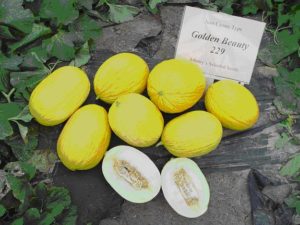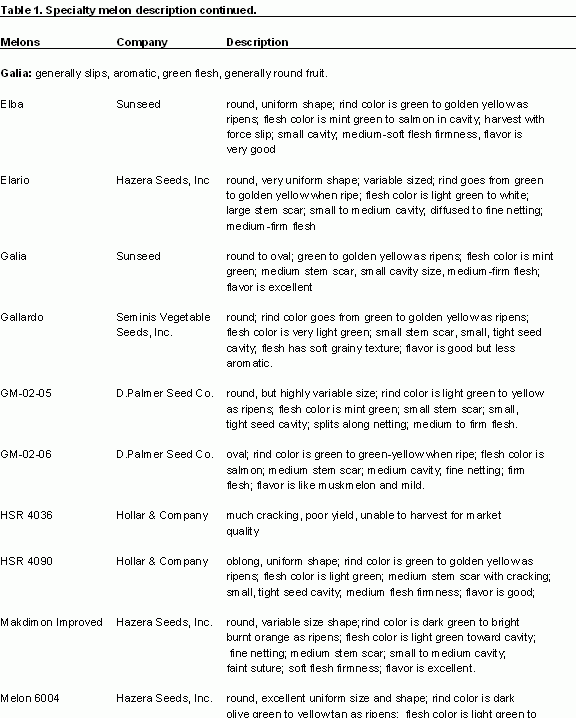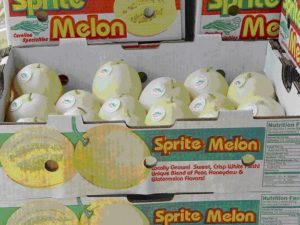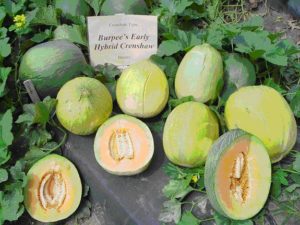Screening and Advancing New Specialty Melons for Market Potential
go.ncsu.edu/readext?451700
en Español / em Português
El inglés es el idioma de control de esta página. En la medida en que haya algún conflicto entre la traducción al inglés y la traducción, el inglés prevalece.
Al hacer clic en el enlace de traducción se activa un servicio de traducción gratuito para convertir la página al español. Al igual que con cualquier traducción por Internet, la conversión no es sensible al contexto y puede que no traduzca el texto en su significado original. NC State Extension no garantiza la exactitud del texto traducido. Por favor, tenga en cuenta que algunas aplicaciones y/o servicios pueden no funcionar como se espera cuando se traducen.
Português
Inglês é o idioma de controle desta página. Na medida que haja algum conflito entre o texto original em Inglês e a tradução, o Inglês prevalece.
Ao clicar no link de tradução, um serviço gratuito de tradução será ativado para converter a página para o Português. Como em qualquer tradução pela internet, a conversão não é sensivel ao contexto e pode não ocorrer a tradução para o significado orginal. O serviço de Extensão da Carolina do Norte (NC State Extension) não garante a exatidão do texto traduzido. Por favor, observe que algumas funções ou serviços podem não funcionar como esperado após a tradução.
English
English is the controlling language of this page. To the extent there is any conflict between the English text and the translation, English controls.
Clicking on the translation link activates a free translation service to convert the page to Spanish. As with any Internet translation, the conversion is not context-sensitive and may not translate the text to its original meaning. NC State Extension does not guarantee the accuracy of the translated text. Please note that some applications and/or services may not function as expected when translated.
Collapse ▲This is an archived report of a NC Specialty Crops Program project that was conducted in 2003. Reviewed by Jeanine Davis, NC Alternative Crops & Organics Program, Department of Horticultural Science, NC State University on 9/9/2022.
PROJECT LEADER(S): Jonathan Schultheis & Bill Jester
TYPE OF PROJECT: Research
LOCATION: Cunningham Research Station, North Carolina
IMPACT
Several melons have been identified which have unique characteristics and are adapted to NC growing conditions. This provides commercial growers with additional choices such that they can grow and market some of these new program melons. For example, an oriental,crisp-flesh melon named Sprite was an unknown commodity over five years ago. Today, it accounts for nearly $2 million in revenue to nearly 25 NC growers and is sold and shipped throughout the United States. Not only does this directly impact growers, but it generates business in allied agriculture like the container or box industry. The end result is the consumer is able to have additional choices of quality melons at the grocery store.
INTRODUCTION
In the southeastern United States, eastern-type muskmelons (cantaloupes) have traditionally been grown for local markets. However, the release of the cultivar Athena has provided growers the opportunity to ship eastern-type melons in significant quantities due to their improved shelf life. The increased commercial shipments that have resulted from the use of the improved cultivar Athena illustrates how superior cultivars can change an industry. Since 1997, as part of the Specialty Crops Program in North Carolina, advanced lines or cultivars of various melon types not traditionally grown in North Carolina have been screened and evaluated for market potential.
The primary goal of the melon screening program is to assess advanced lines or new cultivars of the various melon types and to determine their adaptation to southeastern United States growing conditions (i.e. North Carolina). Another objective, which is equally important, is to take promising lines or cultivars of the various melon types and test market them for consumer acceptance. It is very important that markets are developed as production factors are being evaluated. Several reports have described tests that involved the evaluation of specialty melons, but it appears that there has been limited market penetration by these specialty products (Elmstrom and Maynard, 1992; Simon et al., 1993a, 1993b). A third objective of the melon evaluation program is to have grower participation in the market development. This is done through informal contacts during the season; through the use of advisory committees, and on-farm demonstrations and cooperation with county agents and farmers. Over 10 on-farm demonstrations of specialty melons were conducted in 2003 (see specific reports for results). The most important goal when all is said and done is to provide North Carolina farmers with a quality product they can grow which produces well, and can be successfully marketed for profit!
METHODS
Before the growing season, seed companies are contacted to obtain seed for a variety of specialty melon types that have unique characteristics. Seed companies donate seeds in all cases as they are interested in their cultivar and product lines and how they grow and produce in the southeastern United States, and if they have market potential. As mentioned earlier, the primary melon type grown and marketed in North Carolina is muskmelon. Thus, all other melon types (i.e. juan canary, ananas, charentais, Crenshaw, piel de sapo (Christmas), casaba, Japanese, etc.) are considered specialty types. This includes honeydew melons since these are not grown in any great quantity in North Carolina.
Once all seed were obtained, they were sown in transplant trays in mid-March. Approximately 5 weeks after seeding, the plants were established in the field. Fertilizer was incorporated prior to the laying of black polyethylene plastic (1.25 mil thick). Methyl bromide was injected at the time the plastic was layed. Spacing between row middles was 5 feet and in-row spacing was 2. Plot size was one row of 15 melon plants for the specialty melon observations with four replicates of 10 plants for the honeydew cultivar evaluation study (see honeydew report). At time of transplant, a starter solution was applied using 20-20-20 (1 lb/50 gallons water) and Diazinon (3 oz/50 gallons water) for insect control. Trickle irrigation was utilized (T-tape, 8 mil, 12 inch spacing, 0.34 gph; T-Systems International, Inc. San Diego, California) over the growing season. Fertigation was initiated one week after planting and applied weekly. Fertilizer schedule and rates were applied according to muskmelon crop recommendations (Sanders et al., 2003). Likewise, pesticides were typically applied weekly as a preventative measure beginning about two to three weeks after transplanting (North Carolina Cooperative Extension Service, 2000-2003).
Harvest was every 2 to 4 days for the melon screening study. Evaluations of each melon entry included yield, production earliness, soluble solids using a hand held refractometer, fruit shape and size, exterior and interior descriptions, flavor, flesh texture, disease susceptibility/tolerance and harvesting criteria (i.e. slip vs does not slip). Based on this information, cultivars or advanced lines which showed potential for commercial production will be included in a screening or evaluation trial in 2004. Melon entries with obvious defects or no special features will not be evaluated in 2004.
RESULTS
Each of the melon types are described in table 1. Specific descriptions are given for each melon entry as well. The second table contains yield information for the season as well as categorizes yields into early, mid, and late season.
CONCLUSION
Several of the ananas melons show promise with some of the best ones being from Hollar Seed Company (i.e Duke and HSR 4018R). Harvest time is critical with this type of melon because the shelf life is limited compared with most other melon types that have been tested. Researching and finding ways to extend shelf life on this type of melon may make this melon type more suitable for commercial shipping. Until shelf life extension can be obtained, it will be difficult to include this melon type in shipping markets.
Another melon type which is very tricky to grow is a Charentais melon. These are typically grown in protected culture in Europe where water can be precisely managed. Water management is especially critical since sudden fluctuations or increases in moisture usually result in cracked fruit. In 2003, the HMX 9606 line was the most resistant to cracking of the three entries tested. This melon needs to be harvested at the ¾ slip stage to reduce the incidence of cracking.
Growers might find some success in growing and selling Crenshaw melons for local markets. Of the two we tested, Burpee’s Early was best.
Another year is needed to evaluate a number of the Galia melons evaluated in 2003. If interested in growing a Galia type melon, one should realize that the shelf life on this melon is limited as well. It is not as good as a muskmelon, but generally better than an ananas melon. Some of the melons cultivars that have performed well in previous years are Golan 329 (Hazera) and Sunny Gal (Sunseed). Some of the Seminis lines were especially interesting last year due to their unique flavors.
The juan canary melon is another melon type that has grown well in North Carolina. Several cultivars are well adapted; Sonora, an older cultivar, and Golden Beauty 229, a cultivar well liked by Mr. Food, a culinary expert. Bartlett Hybrid is another exciting cultivar which shows real promise. It was tested for the first time in 2003 and is very sweet and has a special pear-like flavor.
The Christmas melons have been a challenge to grow in North Carolina due to their requirement for a longer time to ripen. Because of this, disease is more difficult to control over the longer period of time necessary to grow this type melon. The hot, humid growing conditions of North Carolina are conducive to increased disease versus dry, warm growing conditions. In spite of the challenge in growing the Christmas melons, Sancho did produce some wonderful tasting fruit which were rated very high at the Specialty Crops field day in July 2003.
One last melon very worthy of comment is Sugar Nut. This is melon that does not fit well into any of the melon type categories. It is being pilot trialed on three commercial farms in 2004. The melon was extremely sweet with excellent flavor.
As one can see, there are many different melons from which to choose. When trying a new cultivar or melon type, be sure to grow a small amount in order to develop markets and learn how to best grow and manage it. Extensive testing will continue in 2004 as nearly 50 melon lines/cultivars will be evaluated.
PHOTOS

Photo 1: Melon that has an excellent appearance, tastes very good and yields well. Potential program melon – an example of a juan canary or casaba type which is likely a cross between the two types





